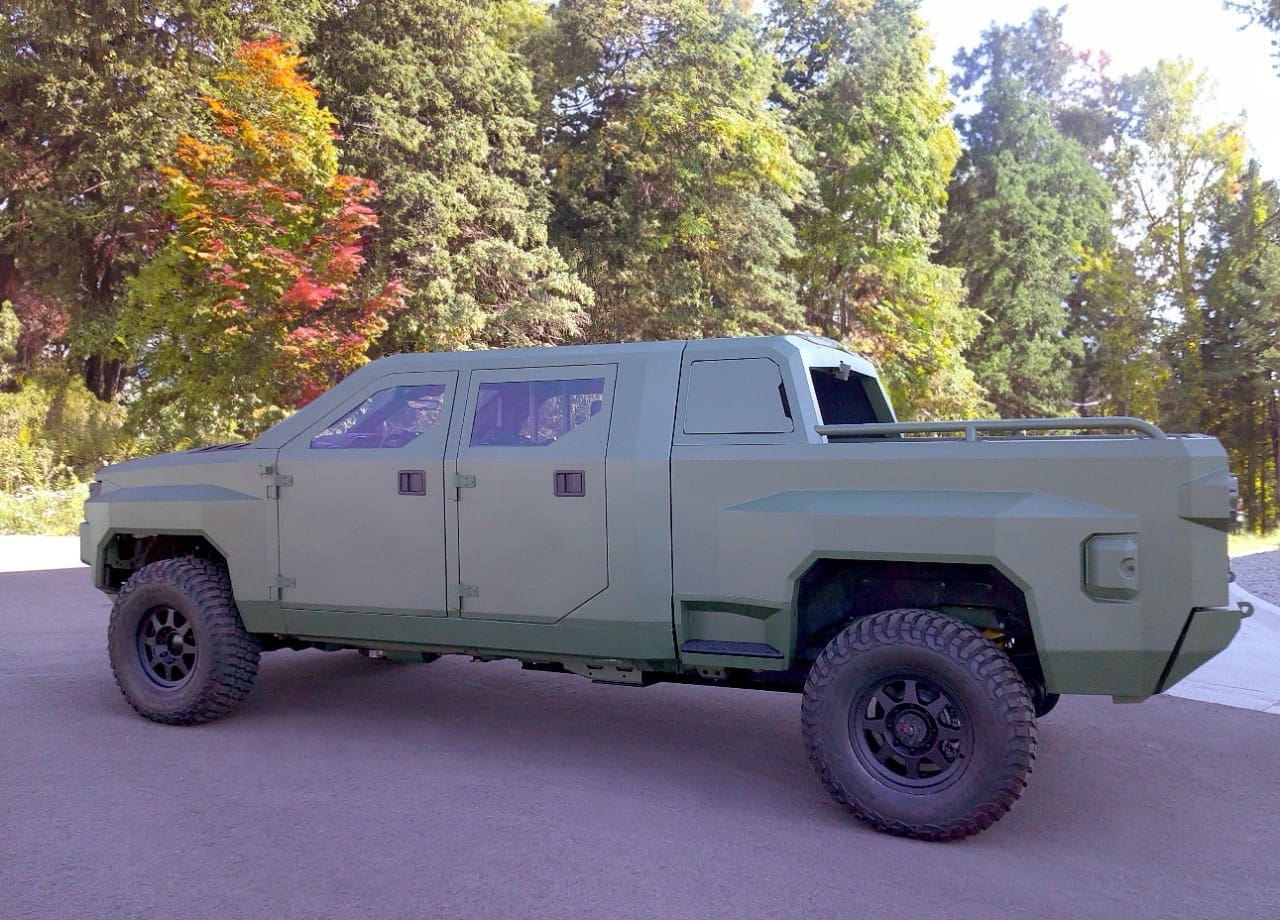GM Defense, a subsidiary of General Motors (GM), unveiled its new “Next Gen” tactical vehicle prototype at this week’s AUSA 2024, the annual meeting and exposition of the Association of the U.S. Army.
Based on the Chevrolet Silverado 2500HD ZR2 truck, the rugged and durable Next Gen combines GM’s 2.8L Duramax® turbo-diesel engine with a 12-module battery pack, in addition to drive motors for the front and rear axles that enable Silent Drive and Silent Watch, technologies that make the vehicles harder to detect.

Side view of GM Defense’s Next Gen tactical vehicle
The technologies enable stealthy ingress and egress through high threat zones, with onboard power to support high-energy-demand sensors, shooters, and Soldier kit. The vehicles offer active and passive safety features, including roll-over protection, anti-lock braking, electronic stability control, four- and five-point seat belt harnesses, and 360-degree camera capabilities.
“Our Next Gen vehicle is a game-changing mobility solution that delivers tactically significant capabilities by integrating GM’s proven commercial technologies,” said Steve duMont, president of GM Defense. “This rugged and highly capable diesel-powered vehicle offers tactical advantages, such as Silent Operations, exportable power, and increased range with extended mission duration. Our warfighters deserve the latest technology that industry can offer in order to gain and maintain competitive advantage over our adversaries. Our Next Gen mobility solution can be customized and fielded now.”
Next Gen offers the following tactical advantages:
• Silent Drive and Silent Watch, enabling low acoustic and thermal signatures;
• Exportable power capable of charging mission systems;
• Tactically significant range with extended mission duration;
• Designed to be autonomy-ready with manned and unmanned options; and
• Add-on armor capable.
In addition, Next Gen provides sustainment benefits, including:
• Fuel demand reduction;
• The ability to use existing JP8 fuel infrastructure;
• Lower maintenance requirements from reduced parts and subsystems in the overall propulsion system; and
• Reduced logistics tail for fuel, batteries, and vehicle parts.
“Next Gen’s ‘wow’ factor is right behind the wheel,” said John ‘JD’ Johnson, vice president of GM Defense’s Government Solutions and Strategy Division. “Customers need to drive this highly capable vehicle to see, feel, and hear the benefits. Next Gen fundamentally changes the discussion around modern mobility through the tactical benefits delivered by its propulsion system, including its ability to address the power gap in the formation. This highly capable tactical vehicle leverages billions of dollars of investments GM has made in R&D and innovation to enhance warfighter capability. We encourage customers to test drive it so that we can get these capabilities fielded immediately.”
Next Gen is offered in two-, four-, and six-seat configurations. The vehicle will be optimized to support multi-mission capabilities, including command and control, launched effects, network extension, counter unmanned aerial systems anti-armor, casualty evacuation, and other critical missions.


I would like to see a civilian version of this truck made available. In light of the storms we get in the US, this truck would be useful especially when the power goes out.
Question – does it have a baseline armor package or only added armor?
It’s a concept vehicle. Weight and electric drive train aren’t congruent.
JLTV is a maintenance nightmare. It was suppose to be less maintenance than the HMMWV, but it isn’t. It is giant and heavy and not any better than either the HMMWV or the M-ATV.
Important to note that the JLTV costs nearly $400,000 each!!! For a glorified pick up truck with armor on it. If Ukraine has taught us anything, bespoke expensive and proprietary vehicles and equipment are simply not worth it in LSCO against a peer or near-peer adversary.
We need a simple, reliable, capable armored 4×4 truck that can be maintained not just by soldiers in the field but also the domestic industrial base.
It was never going to be a proper replacement for the HMMWV. At this point, ISV is as close as they’ll get.
Very interesting point of view. I like the point of view of continuous improvement. Interesting thought about bespoke and proprietary technology. The United States of America holds technology rights over the JLTV now made by AM General. At least from what I understand there is sharing of rights between partners at least to produce it. Each combat program has issues. The original HMMWV did not have ABS, stability control and armor. Now it does comes with ABS because the lack there of was an issue.
High level mandatory requirements like: “simple, reliable, capable armored 4×4 truck that can be maintained not just by soldiers in the field but also the domestic industrial base.” It is very difficult to meet these high level requirements with commercial/consumer technological principles. The added weight of armor, the center of gravity change and the ability to safely travel at speed and over rough terrain are not part of commercial/consumer vehicles that stay on paved roads and gravel. Let alone the security requirements behind armored vehicles.
Sure there is significant tech out there. And more coming all the time:
Scania makes a emissions compliant engine with no need for DEF.
Dupont just announced 30%-40% light kevlar.
LF30 30mm chain gun with air burst ammunition
At least you have armored vehicles. Some of us have nothing.
You could throw a bunch of guys in the back of a Humvee and drive across base. You could also go pick up a bunch of junk at supply try doing that with a JLTV.
Makes sense,
there is a utility model https://warwheels.net/images/JLTVutlUSA%20(3).jpg
I have no idea who gets these… order them?
With that said hummers are still being made.